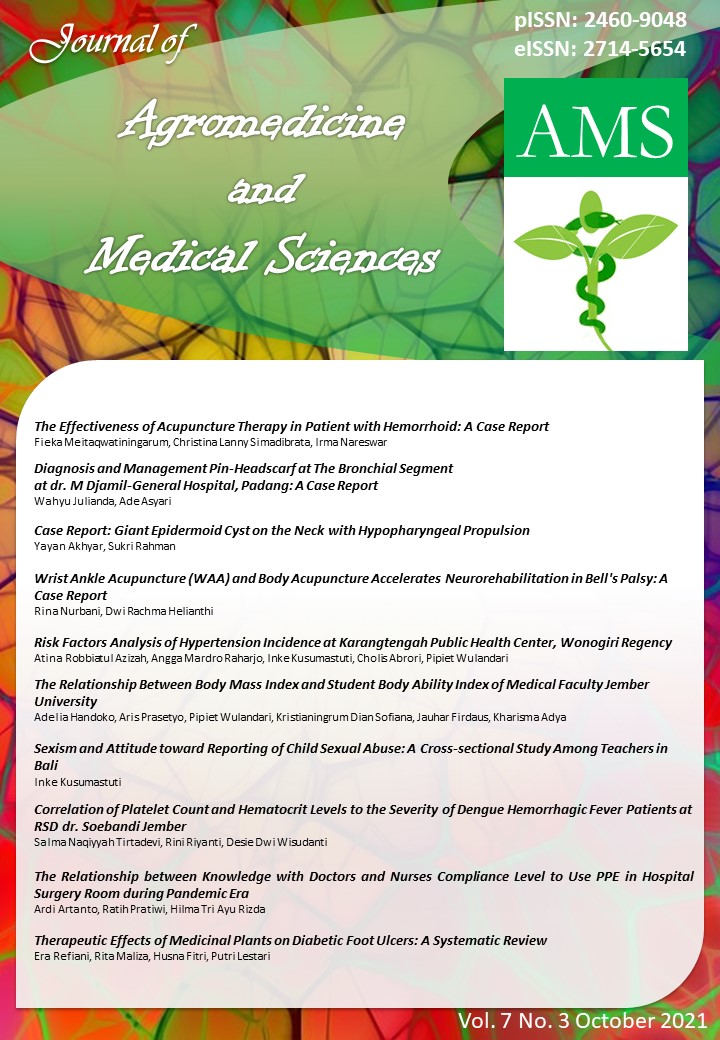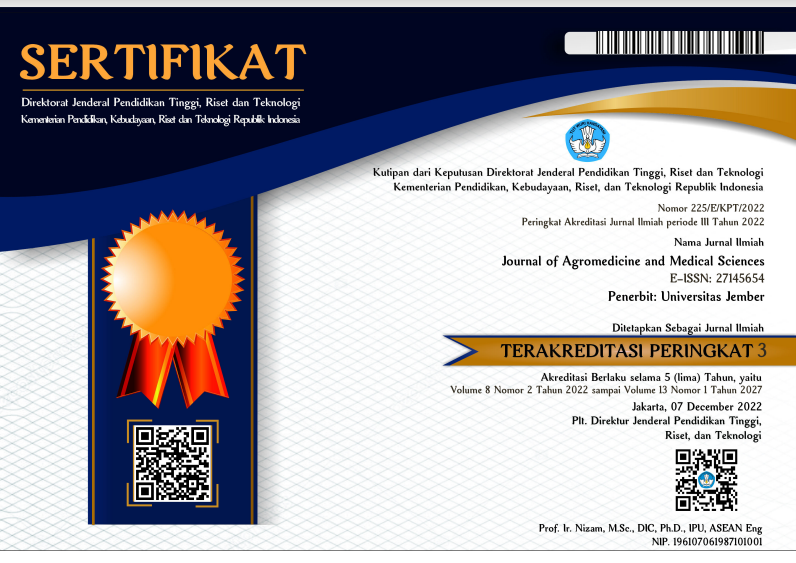The Relationship between Knowledge with Doctors and Nurses’ Compliance Level to Use PPE in Hospital Surgery Room during Pandemic Era
DOI:
https://doi.org/10.19184/ams.v7i3.23875Abstract
Hospitals are not only as a place of treatment, but also as a health service facility that can be a source of infection for other people. Doctors, nurses and other medical personnel are often exposed to potential hazards in hospitals, thus requiring protection in the form of personal protective equipment (PPE). However, compliance with the use of PPE is not always high, which makes doctors and nurses more vulnerable to risk of occupational diseases in hospitals. In one of conducted studies, the conditions that were less compliant in using PPE for health workers were 30%. One of the things that might affect this level of compliance is knowledge about PPE. The purpose of this study was to determine the relationship between knowledge and compliance level to use personal protective equipment among doctors and nurses in operating room installation from a private hospital in 2020. Analytic observational by using cross sectional research design was used in this study. The population were all doctors and nurses at operating room installation of mentioned hospital above. Sampling was taken by total sampling method and 26 samples met the inclusion criteria. In this study, there were 23 respondents (88.5%) obeyed the use of personal protective equipment, meanwhile 3 respondents (11.5%) who did not. The 3 respondents were on loop or circular nurses. So, there was a significant relationship between the level of knowledge and compliance in the use of personal protective equipment with p-value = 0.027and OR=44.
Keywords: personal protective equipment, knowledge level, compliance level
Downloads
References
Azzahri LM & Ikhwan K. (2019). Hubungan Pengetahuan Tentang Penggunaan Alat Pelindung Diri (APD) dengan Kepatuhan Penggunaan APD Pada Perawat di Puskesmas Kuok. PREPOTIF Jurnal Kesehatan Masyarakat, 3(1), p.50-57. doi: 10.19184/ikesma.v17i1.2245
Deressa, W., Worku, A., Abebe, W., Gizaw, M., & Amogne, W. (2021). Risk perceptions and preventive practices of COVID-19 among healthcare professionals in public hospitals in Addis Ababa, Ethiopia. PLOS ONE, 16(6), e0242471.
doi: 10.1371/journal.pone.0242471
Haque M, Sartelli M, McKimm J, & Abu Bakar M. (2018). Health care-associated infections – an Overview. Infection and Drug Resistance, 11, p.2321–2333. doi: 10.2147/idr.s177247
Hartmann, S., Rubin, Z., Sato, H., O Yong, K., Terashita, D., & Balter, S. (2020). Coronavirus Disease 2019 (COVID-19) Infections Among Healthcare Workers, Los Angeles County, February–May 2020. Clinical Infectious Diseases, 73(7), p. 1850–1854. doi: 10.1093/cid/ciaa1200
Khoeirudin MP, Yudianto K, & Shalahuddin I (2020). Nurses’ Attitude on The Use Of Personal Protective Equipment (PPE) in Emergency Room of dr. Slamet Hospital Garut. Journal of Nursing Care, 3(2), p.119-127.
https://doi.org/10.24198/jnc.v3i2.24437
Kurnia NU, Asparian, & Nurdini L. (2021). Faktor-Faktor Yang Berhubungan Dengan Penggunaan Alat Pelindungdiri (APD) Pada Petugas Penyapu Jalan Dinas Lingkungan Hidup Kota Jambi Tahun 2020. MEDIC, 4(1), p. 185-197.
Madjid T & Wibowo A. (2017). Analisis Penerapan Program Pencegahan dan Pengendalian Infeksi di Ruang Rawat Inap RSUD Tebet Tahun 2017. Jurnal Administrasi Rumah Sakit Indonesia, 4(1), p.57-68.
http://dx.doi.org/10.7454/arsi.v4i1.3205
Nasrullah M & Suwandi T. (2014). Hubungan Antara Knowledge, Attitude, Practice Safe Behavior Pekerja Dalam Upaya Untuk Menegakkan Keselamatan Dan Kesehatan Kerja. The Indonesian Journal of Occupational Safety and Health, 3(1), p.82-93.
Notoatmodjo, S. (2014). Metodologi Penelitian Kesehatan. Jakarta: Rineka Cipta
PERDOKI. (2020). Panduan Perlindungan Bagi Pekerja Di Fasilitas Pelayanan Kesehatan Dalam Masa Pandemi Covid – 19. PERDOKI: Jakarta
Prasetyo E. (2015). Pengaruh Pengetahuan, Sikap, Dan Ketersediaan Alat Pelindung Diri (APD) Terhadap Kepatuhan Dalam Menggunakan Apd Di Unit Coating Pt. Pura Barutama Kudus. Jurnal Keperawatan dan Kesehatan Masyarakat, 4(1), p. 49-60. doi: 10.31596/jcu.v2i3.64
Rinawati S, Widowati NN, & Rosanti E. (2016). Pengaruh Tingkat Pengetahuan Terhadap Pelaksanaan Pemakaian Alat Pelindung Diri Sebagai Upaya Pencapaian Zero Accideent di PT X. Journal of Industrial Hygiene and Occupational Health, 1(1), h.53-67. doi: 10.21111/jihoh.v1i1.606
Riyadi & Larasati P. (2020). Faktor Yang Berpengaruh Terhadap Kepatuhan Masyarakat Pada Protokol Kesehatan Dalam Mencegah Penyebaran Covid-19. Prosiding Seminar Nasional Official Statistics 2020; Pemodelan Statistika Tentang COVID-19, 2020(1), p.45-54.
Safarina D, Suryawati C, & Sutiningsih D. (2021). Factors Affecting the Behavior of Doctors and Nurses on the Prevention of COVID-19 at K.R.M.T Wongsonegoro Hospital. Public Health Perspectives Journal. 6(2), p. 234-239.
Tombokan C, Warountu O, & Buntuan V. (2016). Potensi Penyebaran Infeksi Nosokomial Di Ruangan Instalasi Rawat Inap Khusus Tuberkulosis (Irina C5) Blu Rsup Prof. Dr. R. D. Kandou Manado. Jurnal e-Biomedik, 4(1), p.1-8. doi: 10.35790/ebm.v4i1.11247























